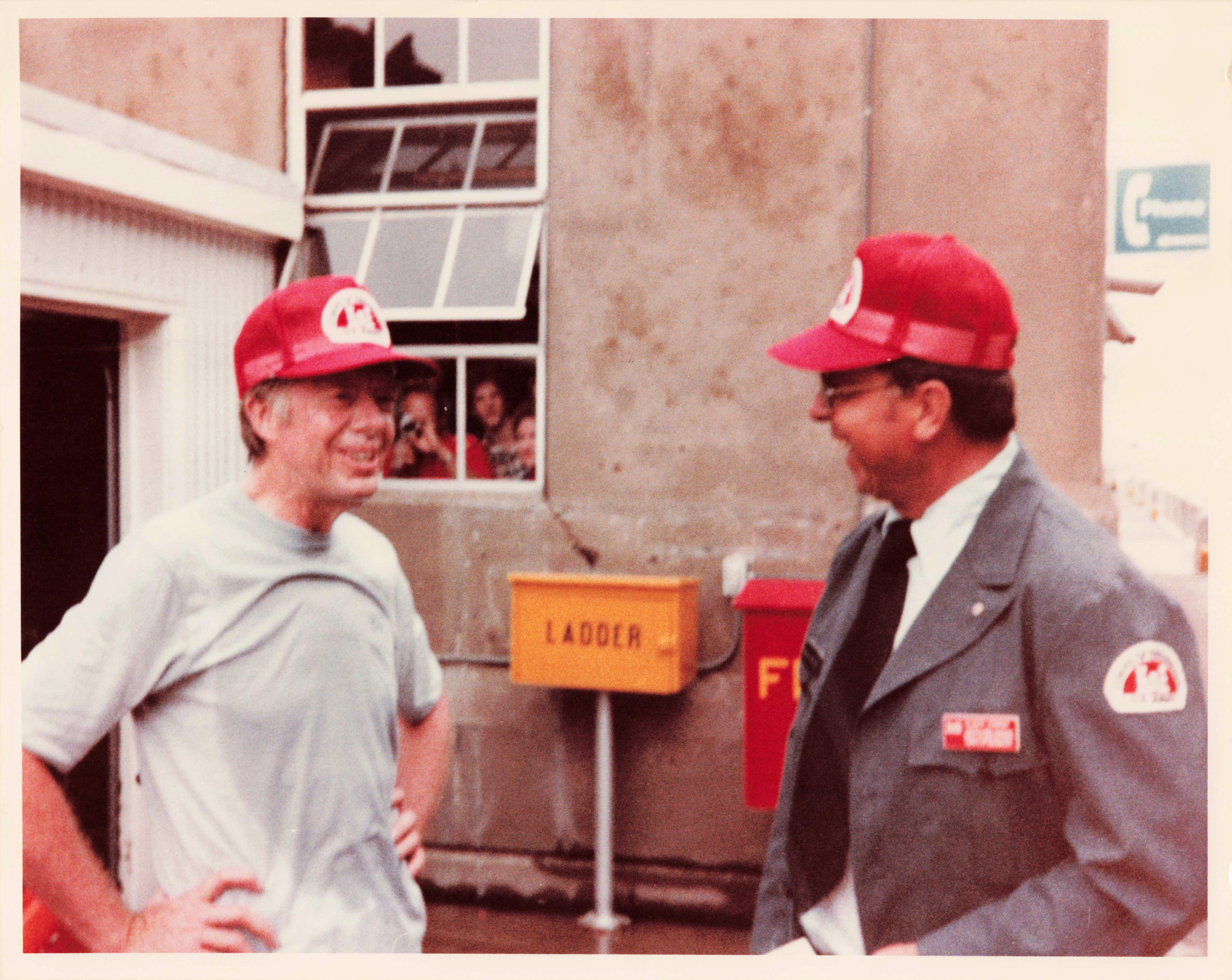| |
 |
| |
After a morning jog around the facility, President Carter speaks with Lockmaster Gilbert Currier at Lock and Dam #11 on Mississippi River. In 1979 Carter was traveling on the steamship Delta Queen with his family on a tour of the Upper Mississippi.
Office of History, USACE
|
President Jimmy Carter, elected in 1976 at the height of an era of new environmental regulations, was highly critical of water resources projects that he considered too costly, inefficient, or environmentally damaging. Many of those older projects had seen little progress in over a decade when Carter entered office. Carter’s so-called “hit list” originally aimed to eliminate thirty U.S. Bureau of Reclamation and U.S. Army Corps of Engineers projects that he saw as both economically unjustifiable and overly harmful to the environment. But after aggressively scrutinizing several such projects and wrangling with Congress over their fate, only nine major projects were deauthorized, and three were extensively modified, by 1978. For example, the Tennessee-Tombigbee project, a massive undertaking for inland navigation across the southeast, faced significant environmental opposition and carried a high price tag but eventually proceeded with substantial mitigation measures, while the Meramac Dam project in Missouri attracted similar concerns and was ultimately deauthorized.
Carter’s approach prompted the Corps to rethink and redesign projects to be more environmentally friendly and economically sound and to serve the national interest, a process that had already been underway in the Corps’ own recommendations to Congress as hundreds of older projects faced changing levels of local support and new national priorities. Chief of Engineers Lt. Gen. John W. Morris later said the agency had “welcomed” Carter’s reappraisal of its projects, which helped to “clear the air” in determining which of the previously authorized projects were still compatible with new laws passed in the past decade.
Carter’s reappraisal of large dam projects encouraged the Corps to design less environmentally intrusive projects and heightened the focus on mitigating environmental damage in civil works. Under his administration, the Corps began to refocus on nonstructural flood risk management alternatives, such as floodplain management and wetland restoration. Although nonstructural approaches were not new to the Corps, Carter directed the agency to encourage their wider use. Despite some skepticism in the years after Carter left office, major flooding across the Midwest in 1993 highlighted the need for a broader application of nonstructural solutions, one that has continued to evolve today into a new civil works approach of “engineering with nature.”
Carter’s term also saw a greatly heightened emphasis on dam safety, spurred by several catastrophic dam failures in the early 1970s. Although the dams that breached were not Corps projects, Congress authorized the agency and the Bureau of Reclamation to conduct an inventory of dams in the United States and to make recommendations for a robust dam safety program. The Corps inventoried nearly 50,000 dams and found that many had not been inspected before and posed significant risks. The deadly failure of the federal Teton Dam in Idaho and the locally owned Kelly Barnes Dam in Carter’s home state of Georgia in 1976 led his administration to mandate a comprehensive inspection of non-federal dams, though this broad initiative met resistance from some state officials. The Corps’ Dam Safety Assurance Program and the establishment of the Interagency Committee on Dam Safety helped to begin addressing these concerns.
The eruption of Mt. St. Helens in 1980 prompted a huge response from the Corps and was the origin of its decades-long commitment to ecosystem restoration. The eruption deposited nearly four billion cubic yards of debris, boulders, earth, and giant masses of ice into Spirit Lake and the adjoining valley in a tremendous avalanche, leading the Corps to undertake extensive emergency dredging and levee construction to prevent further damage. Four days after the explosion, Carter described it as “The worst thing I have ever seen…. There’s nothing left but massive piles of mud and what used to be mountain…. It’s an unbelievable sight.” Five years later the Corps had completed a long-term plan to manage sediment, mitigate flood risk, and restore the region’s aquatic ecosystems.
Perhaps Carter’s most significant environmental legacy was signing the Comprehensive Environmental Response, Compensation, and Liability Act (CERCLA) in 1980, creating a “Superfund” for hazardous waste cleanup. The Corps assisted the Environmental Protection Agency in managing contracts and providing technical assistance for cleanup efforts, with significant early contributions from the Missouri River Division and the Kansas City District in designing the cleanup program. Carter’s establishment of the Superfund marked a pivotal moment in environmental protection, addressing the urgent need to remediate contaminated industrial, and later, defense sites, and prevent further environmental damage. His administration’s actions laid the framework for ongoing efforts to manage and clean up hazardous waste across the United States.
***
January 2025. No. 167.